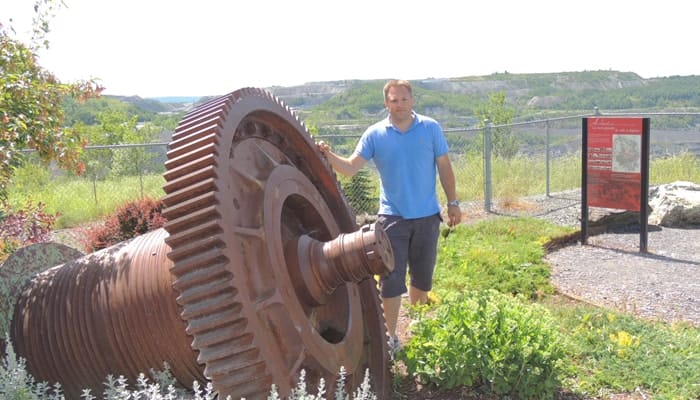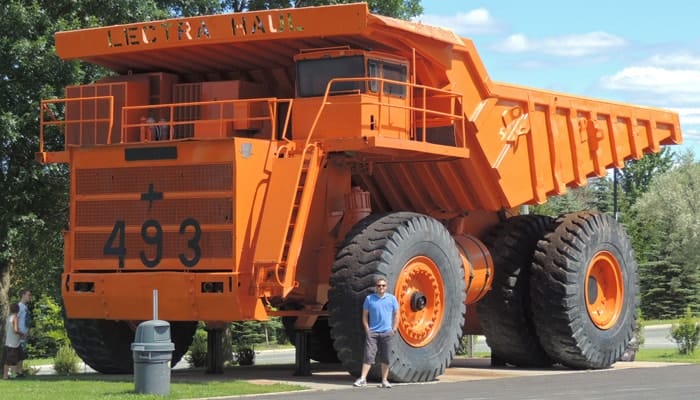The Canadian town of Asbestos, on the Nicolet River in the south-east of the country’s largest province, French-speaking Quebec, is adopting a new identity for itself with a moniker chosen by townspeople. And our own Simon Evans, managing director of Core Surveys, has himself visited the town of Asbestos himself back in 2014, when he gained a fascinating insight into how the mineral is sourced.
The place was, as its former name implies, for many years the site of significant mining of the potentially lethal substance. Indeed, Asbestos was once the site of the biggest mine for the fibre in the world, and was built in the late 1870s following the discovery of an asbestos deposit.

Asbestos Industry links
The decision to rename the settlement, lying 93 miles east of Montreal and with around 7,000 inhabitants, wasn’t without controversy. Many who live there appreciate the town’s link to the industry which at one time gave so many local people their livelihoods. (Jeffrey mine was the town’s biggest employer.) And many still have or remember family members who worked at the asbestos mines, and so feel an attachment to that aspect of local history, although operations ceased in 2011.
How was the new name for the town of Asbestos decided?
Everyone living in Asbestos who was 14 or older was allowed to take part in a four-day poll to decide what the place should be called – and hundreds of ideas for a new name were submitted.
While Boaty McBoat Face wasn’t among them, the suggestions were whittled down to a handful. Among them was Phénix, French for the bird of legend who famously arises from the ashes, and has a namesake in Arizona. (However, asbestos is actually frequently a cause of worry after significant blazes.) A turtle species, Apalone, was another proposal, as was Trois-Lacs or three lakes, the name of one of the town’s districts.
Yet another idea was Jeffrey, which may sound entertainingly random but the town’s biggest asbestos mine was funded by a W H Jeffrey in the late nineteenth century. Interestingly, this choice was controversial because it would have given the area an English title, rather than one in French, the language most residents have as their first tongue. Equally, Jeffrey would have retained the area’s connections with the asbestos industry.
No one suggested the word for asbestos in French, amiante.
According to the town’s mayor, Hugues Grimard, the name Asbestos had put off a number of investors over the years.
New moniker for Asbestos revealed
The name change was delayed by the coronavirus pandemic, but the referendum result, announced in mid-October, led to a vote of 51.5% in favour of the new name of Val-des-Sources after three rounds of voting, rather than any of the other five suggestions put forward. It is hoped that the official changeover will take place before December – provincial government still has to approve the decision.
Grimard insists that the new name, which refers to the town’s location at the meeting point of three lakes “represents our area, and, especially, it’s inspiring for the future.”
Val-des-Sources according to the blurb, is a “fusion of our history and our roots”.
Former mayor Louise Moisan-Colombe told broadcasters that while the town previously took pride in its name, “now it’s very difficult because it’s a fibre that people are afraid of”.
In 2012, a loan promised to restart mining in Asbestos for the next two decades was withdrawn after the provincial government changed following an election. Funding was instead provided to diversify the area economically.
Asbestos: a brief history
Archaeological evidence shows asbestos was used as long ago as the Stone Age. The term describes six naturally occurring silicate minerals, made up of long, thin fibrous crystals, each one comprising numerous microscopic ‘fibrils’ that abrasion and similar processes can release into the air.
Heat-resistant and a great electrical insulator, the material has of course been widely used in construction over the years. However, inhaling its fibres can result in a number of grave health conditions, including asbestosis and cancer.
So its use in new building is illegal in many nations across the world, including the UK, although mining continues in some places, and it’s still used in the building industry. Leading producer Russia, for example, mined around a million tonnes of asbestos in 2015.

Let us help you with your asbestos needs
The fact that a whole town has taken the radical decision to change its identity despite historical links with the industry and mining, shows just how deeply negative connotations are associated with this substance, and the risks involved with this material.
At Core Surveys, we can help with our team of specialists providing accredited asbestos surveys, air testing, consultancy and training courses, covering Sussex, Brighton, Kent and Surrey from our Sussex Offices and Wales, Bristol, Swansea and Cardiff from our Wales offices . What’s more, our track record is of proven results.
Get in touch today to learn more, whatever your needs and building type.
